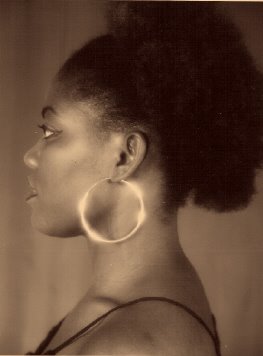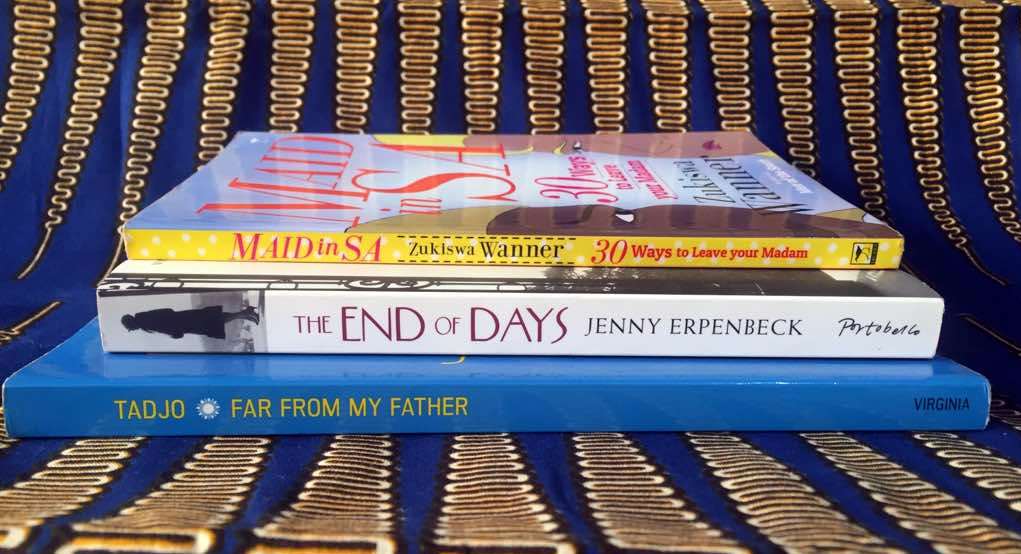When the Orange Lady Came to Ife
Words & Images by Adedotun Eyinade
 Not even the organizers expected the massive turnout that the event witnessed; perhaps that was what informed the recourse to the thespian venue. Examinations, though winding to a close, were still very much in the air and students were already exiting the campus for the weekend. In spite of these odds, students, lecturers and art enthusiasts in general, trooped out in their hundreds to watch Chimamanda Ngozi Adichie, the Orange-prize winning author read from her acclaimed works.
Not even the organizers expected the massive turnout that the event witnessed; perhaps that was what informed the recourse to the thespian venue. Examinations, though winding to a close, were still very much in the air and students were already exiting the campus for the weekend. In spite of these odds, students, lecturers and art enthusiasts in general, trooped out in their hundreds to watch Chimamanda Ngozi Adichie, the Orange-prize winning author read from her acclaimed works. Pit Theatre, venue of the book reading, was on Friday August 3, 2007 filled with an enthusiastic audience who had started trickling into the venue hours before the arrival of the author. The author, clad in a snazzy light-green top on a black skirt, sauntered into the venue at about 4.00pm in company with Binyavanga Wainana, the Kenyan founding editor of Kwani?, the literary magazine that has produced other Caine-prize winning authors like him.
Pit Theatre, venue of the book reading, was on Friday August 3, 2007 filled with an enthusiastic audience who had started trickling into the venue hours before the arrival of the author. The author, clad in a snazzy light-green top on a black skirt, sauntered into the venue at about 4.00pm in company with Binyavanga Wainana, the Kenyan founding editor of Kwani?, the literary magazine that has produced other Caine-prize winning authors like him. The duo who had recently facilitated a creative writing workshop in Lagos were the guests of the Faculty of Arts, Obafemi Awolowo University, Ile-Ife.
The duo who had recently facilitated a creative writing workshop in Lagos were the guests of the Faculty of Arts, Obafemi Awolowo University, Ile-Ife.In his opening remarks, Dr Chima Anyadike, lecturer in the Department of English said the hosting of the author was in sync with the tradition of the Faculty in creating a platform for celebrated authors to showcase their works. He reeled out a list of revered literary figures- Amos Tutola, Nadine Gordimer- who had been hosted in the past. He expressed delight that the audience trooped out in throngs to grace the event.At exactly 4.40pm, Chimamanda Adichie mounted the soapbox to read from her two books. She commenced with Purple Hibiscus, a novel that launched her into literary reckoning, regaling her listeners with the haunting tale of Jaja and Kambili. The audience, many of whom were attending a reading for the first time, equally followed with keen attention, the reading of the rave-making Half of a Yellow Sun. With a voice that throbbed with passion and vim, she read snatches of the house-boy story, connecting with a responsive audience that did not allow the riveting details of Ugwu, and other larger than life characters of the book elude them.
 The sublimity of her work was brought closer to her audience whom could not help but be immersed in her reading. Binyavanga Wainaina, who wrote the seminal satire, How to Write About Africa, was invited to read excerpts from his forthcoming novel, Discovering Home. Binyavanga, whom Adichie described as “a writer for whom I have deep respect” took the audience through memorable moments of growing up in post-independence Kenya. Discovering Home, a mini-biography, is a novelistic adaptation of the short- story that won him the Caine Prize for African Writing in 2002. The magazine Kwani? which he established after winning the prize has also produced another winner, Kenyan Yvonne Adhiambo Owuor, who won in 2003.
The sublimity of her work was brought closer to her audience whom could not help but be immersed in her reading. Binyavanga Wainaina, who wrote the seminal satire, How to Write About Africa, was invited to read excerpts from his forthcoming novel, Discovering Home. Binyavanga, whom Adichie described as “a writer for whom I have deep respect” took the audience through memorable moments of growing up in post-independence Kenya. Discovering Home, a mini-biography, is a novelistic adaptation of the short- story that won him the Caine Prize for African Writing in 2002. The magazine Kwani? which he established after winning the prize has also produced another winner, Kenyan Yvonne Adhiambo Owuor, who won in 2003. Binyavanga, who was in the news recently for rejecting the World Economic Forum’s “Youth Global Leader” award commented on the aesthetic beauty of the University. “I am happy to be in Nigeria. Everything here is beautiful.”
 Everything was not all books and literature, the event was interspersed with a dance performance by the dance troupe of the Department of Dramatic Arts. In an entrancing performance, the graceful dancers thrilled both the guest writers and the audience. Binyavanya appeared particularly enthralled by the dexterity with which the drummers beat the drums.
Everything was not all books and literature, the event was interspersed with a dance performance by the dance troupe of the Department of Dramatic Arts. In an entrancing performance, the graceful dancers thrilled both the guest writers and the audience. Binyavanya appeared particularly enthralled by the dexterity with which the drummers beat the drums. The enthusiasm with which the audience embraced the writers’ works was reflected in the myriad of question directed at them during the question and answer session. Binyavanga was asked why he rejected the WEF award. To this he replied that “I didn’t know what the initiative was about .The letter announcing my nomination was extremely vague.” He further added that he got to hear about the nomination in the press before he got the letter. In reacting to why he made his rejection a public issue, he reasoned that he didn’t send the letter to the public “but to my mailing list.”
The enthusiasm with which the audience embraced the writers’ works was reflected in the myriad of question directed at them during the question and answer session. Binyavanga was asked why he rejected the WEF award. To this he replied that “I didn’t know what the initiative was about .The letter announcing my nomination was extremely vague.” He further added that he got to hear about the nomination in the press before he got the letter. In reacting to why he made his rejection a public issue, he reasoned that he didn’t send the letter to the public “but to my mailing list.” Chimamanda Adichie on her part didn’t shy away from the issue that has been raised as regards her obsession with the colours. ”It is not a deliberate thing.” She credited her editor with coming up with the title “Purple Hibiscus” while Half of a Yellow Sun stemmed from the Biafran flag. “I don’t know if I will set my future books in Nsukka. My work is informed by my background. Nsukka will always influence my writing,” she added, when she was asked about her fixation with the university town of Nsukka.At about 6.33pm, the Faculty of Arts added a fresh award to the growing list of her laurels. The award was presented by Professor Remi Sonaiya of the Department of Foreign Languages. Chimamanda Ngozi Adichie, beaming with her trademark smile, thanked the Faculty for the warm reception accorded her.
Chimamanda Adichie on her part didn’t shy away from the issue that has been raised as regards her obsession with the colours. ”It is not a deliberate thing.” She credited her editor with coming up with the title “Purple Hibiscus” while Half of a Yellow Sun stemmed from the Biafran flag. “I don’t know if I will set my future books in Nsukka. My work is informed by my background. Nsukka will always influence my writing,” she added, when she was asked about her fixation with the university town of Nsukka.At about 6.33pm, the Faculty of Arts added a fresh award to the growing list of her laurels. The award was presented by Professor Remi Sonaiya of the Department of Foreign Languages. Chimamanda Ngozi Adichie, beaming with her trademark smile, thanked the Faculty for the warm reception accorded her.Members of the intelligentsia who graced the occasion include Professor Y. K.Yusuf, Head of Department, Department of English, Prof. Adebayo Lamikanra, convener of the Ife Festival of  Poetry, Dr Lere Oladitan, author of Bolekaja and other stories, Dr Funke Ogunleye, head of department, Department of Dramatic Arts.By the time the programme wound to a close, literary enthusiasts filed into a queue to have their copies autographed by the author. It was indeed a yellow day for Ife’s literati.
Poetry, Dr Lere Oladitan, author of Bolekaja and other stories, Dr Funke Ogunleye, head of department, Department of Dramatic Arts.By the time the programme wound to a close, literary enthusiasts filed into a queue to have their copies autographed by the author. It was indeed a yellow day for Ife’s literati.
- Words & Images © Adedotun Eyinade











.jpg)





2 comments:
Thanks a lot Morara,
I am back in Kenya after that exciting tour of West Africa. On my blog's 'favourite writer series' this week I have featured a story from Chimamanda that is, as with all her work, terribly exciting and worth a look from your readers.
We have also just launched the latest edition of our magazine, Kwani? Details of that and all the literary stuff that we are up to is on the Kwani blog:
www.kwani.org/blog
Binyavanga
Thanks for dropping by Binyavanga, and for info on new stuff. Will pop over to these sites pronto.
MW
Post a Comment